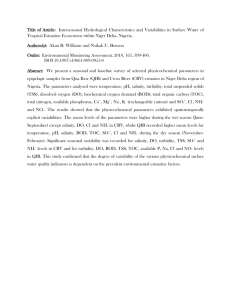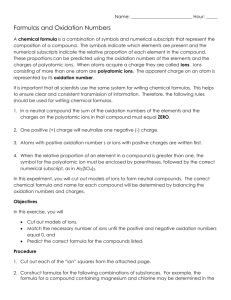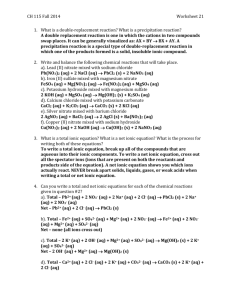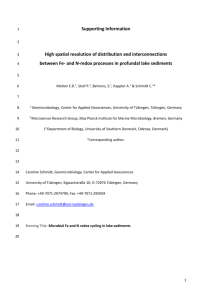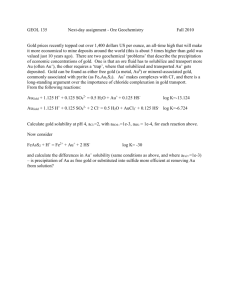Supplementary Discussion (doc 214K)
advertisement
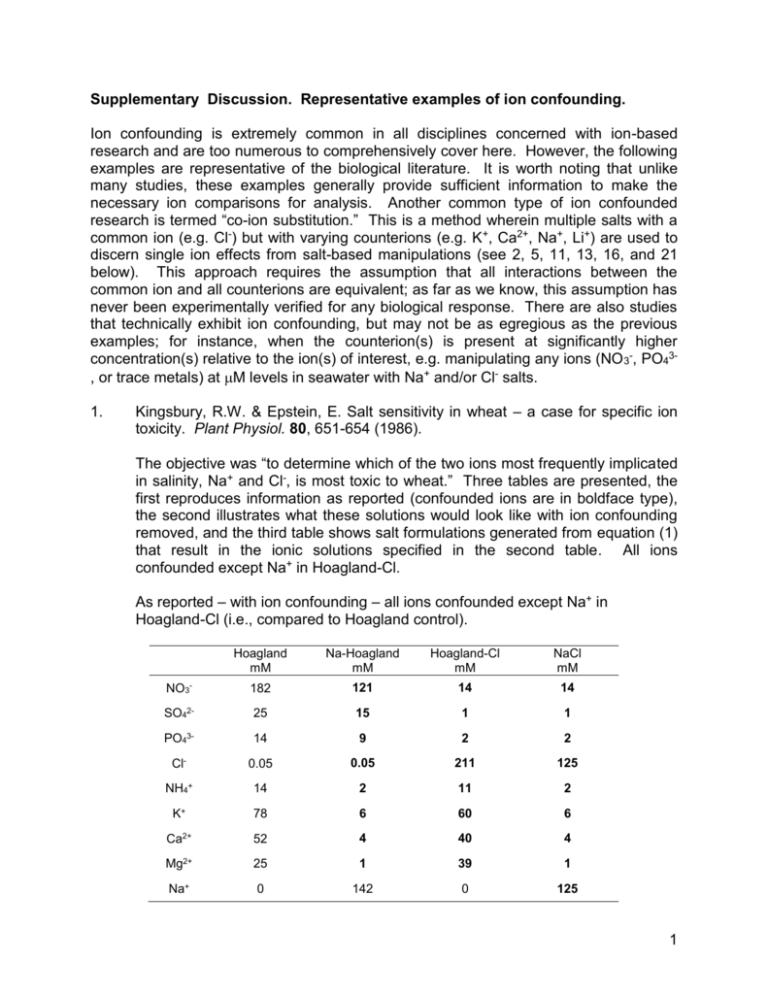
Supplementary Discussion. Representative examples of ion confounding. Ion confounding is extremely common in all disciplines concerned with ion-based research and are too numerous to comprehensively cover here. However, the following examples are representative of the biological literature. It is worth noting that unlike many studies, these examples generally provide sufficient information to make the necessary ion comparisons for analysis. Another common type of ion confounded research is termed “co-ion substitution.” This is a method wherein multiple salts with a common ion (e.g. Cl-) but with varying counterions (e.g. K+, Ca2+, Na+, Li+) are used to discern single ion effects from salt-based manipulations (see 2, 5, 11, 13, 16, and 21 below). This approach requires the assumption that all interactions between the common ion and all counterions are equivalent; as far as we know, this assumption has never been experimentally verified for any biological response. There are also studies that technically exhibit ion confounding, but may not be as egregious as the previous examples; for instance, when the counterion(s) is present at significantly higher concentration(s) relative to the ion(s) of interest, e.g. manipulating any ions (NO 3-, PO43, or trace metals) at M levels in seawater with Na+ and/or Cl- salts. 1. Kingsbury, R.W. & Epstein, E. Salt sensitivity in wheat – a case for specific ion toxicity. Plant Physiol. 80, 651-654 (1986). The objective was “to determine which of the two ions most frequently implicated in salinity, Na+ and Cl-, is most toxic to wheat.” Three tables are presented, the first reproduces information as reported (confounded ions are in boldface type), the second illustrates what these solutions would look like with ion confounding removed, and the third table shows salt formulations generated from equation (1) that result in the ionic solutions specified in the second table. All ions confounded except Na+ in Hoagland-Cl. As reported – with ion confounding – all ions confounded except Na+ in Hoagland-Cl (i.e., compared to Hoagland control). Hoagland mM Na-Hoagland mM Hoagland-Cl mM NaCl mM NO3- 182 121 14 14 SO42- 25 15 1 1 PO43- 14 9 2 2 Cl- 0.05 0.05 211 125 NH4+ 14 2 11 2 K+ 78 6 60 6 Ca2+ 52 4 40 4 Mg2+ 25 1 39 1 Na+ 0 142 0 125 1 Ion confounding removed. The only difference between the four solutions is the ions of interest, Na+ and Cl-. Hoagland mM Na-Hoagland mM Hoagland-Cl mM NaCl mM NO3- 182 182 182 182 SO42- 25 25 25 25 PO43- 14 14 14 14 Cl- 0.05 0 142 71 NH4+ 14 14 14 14 K+ 78 78 78 78 Ca2+ 52 52 52 52 Mg2+ 25 25 25 25 Na+ 0 142 0 71 One set of nonunique salt formulations derived from equation (1) results in the ionic solutions listed above and removes ion confounding. Approximately 30 salts, acids, and bases were used to solve equation (1). Salts Hoagland mg L-1 Na-Hoagland mg L-1 Hoagland-Cl mg L-1 CaCl2.2H2O Ca(NO3)2.4H2O H2SO4 5,219.56 12,279.85 12,279.85 12,279.85 5,177.32 K3PO4 2,971.77 1,905.20 1,905.20 K2HPO4 KNO3 6,470.59 5.08 MgSO4.7H2O 6,155.56 3,639.71 6,470.59 6,470.59 6,161.73 6,161.73 6,161.73 NaNO3 3,569.61 NaOH 3,999.70 NH4OH 1,905.20 0.003 MgCl2.6H2O NH4NO3 3,896.49 2.45 HCl KH2PO4 NaCl mg L-1 1,120.60 6,034.34 1,120.60 1,120.60 490.70 2 2. Hoagland, D.R. & Arnon, D.I. The water-culture method for growing plants without soil. Univ. Calif. Coll. Agric. Exp. Stn. Circ. 347 (1938). Explained in Table 1 of manuscript. 3. Liu, J. & Zhu, J-K. An Arabidopsis mutant that requires increased calcium for potassium nutrition and salt tolerance. Proc. Natl. Acad. Sci. USA 94, 1496014964 (1997). The Arabidopsis sos3 mutant was isolated and its Ca2+, K+, Na+, and Clrequirements characterized. To determine the sos3 mutant K+ requirement, seedlings were grown on potassium-free 1/20th MS salts supplemented with varying amounts of KCl. To remove the potassium required omitting KNO3 and KH2PO4 and adding (NH4)2HPO4 to restore the PO43-. Compared to 1/20th MS salts without ion confounding the net result was that the effect of removing K+ was confounded with the reduction in NO3- and increase in NH4+. Additionally, Cl- was not held constant but varied along with the K+ due to the varying amounts of KCl used. To determine the sos3 mutant Ca2+ requirement, seedlings were grown on calcium free 1/20th MS salts containing only 20 µM K+ and supplemented with varying amounts of CaCl2. One objective was to determine seedling growth under very low K+ levels. The final solution was similar to the one above with the removal of KNO3 and KH2PO4 and the adding of (NH4)2HPO4 to restore the PO43. Compared to 1/20th MS salts without ion confounding the net result was that the effect of removing Ca2+ and lowering K+ was confounded with a reduction in NO3- and an increase in NH4+. Additionally, Cl- was not held constant but varied along with the Ca2+ due to the varying amounts of CaCl2 used. 3 4. Tarakcioglu, C. & Inal, A. Changes induced by salinity, demarcating specific ion ratio (Na/Cl) and osmolality in ion and praline accumulation, nitrate reductase activity, and growth performance of lettuce. J. Plant Nutrition 25, 27-41 (2002). The objective was “to separate the osmolalitic effect from the specific ion effects of Na+, Cl-, and Na/Cl ratio…” Two tables are presented, the first reproduces information reported and the second illustrates what these solutions would look like with ion confounding removed. As reported - with ion confounding (compare to control ion levels). NO3- SO42- PO43- Cl- NH4+ K+ Ca2+ Mg2+ Na+ Control 19 1.125 2 0 1.25 11 4.5 1 0 NaCl (40 mM) 19 1.125 2 40 1.25 11 4.5 1 40 Na/Cl (100/0) 19 21.125 2 0 1.25 11 4.5 1 40 Na/Cl (75/25) 19 16.125 2 10 1.25 17 5.5 2 30 Na/Cl (50/50) 19 11.125 2 20 1.25 21 7.5 3 20 Na/Cl (25/75) 19 6.125 2 30 1.25 31 7.5 3 10 Na/Cl (0/100) 19 1.125 2 40 1.25 32 12 3 0 Ion confounding removed. NO3- SO42- PO43- Cl- NH4+ K+ Ca2+ Mg2+ Na+ Control 19 1.125 2 0 1.25 11 4.5 1 0 NaCl - (40 mM) 19 1.125 2 40 1.25 11 4.5 1 40 Na/Cl (100/0) 19 1.125 2 0 1.25 11 4.5 1 40 Na/Cl (75/25) 19 1.125 2 10 1.25 11 4.5 1 30 Na/Cl (50/50) 19 1.125 2 20 1.25 11 4.5 1 20 Na/Cl (25/75) 19 1.125 2 30 1.25 11 4.5 1 10 Na/Cl (0/100) 19 1.125 2 40 1.25 11 4.5 1 0 4 5. Takahashi, H. et al. Regulation of sulfur assimilation in higher plants: A sulfate transporter induced in sulfate-starved roots plays a central role in Arabidopsis thaliana. Proc. Natl. Acad. Sci. USA 94, 11102-11107 (1997). The objective was to induce a sulfate transporter in sulfate-starved roots of Arabidopsis. The solution used to induce SO42- starvation was formulated by replacing the sulphate salts with “equivalent amounts of chloride salts.” This removes SO42- but also increases the [Cl-] from 5.9 mM to 9.6 mM. The measured response is confounded with the changed [SO42-] and [Cl-]. 6. Ellison, A.M. & Gotelli, N.J. Nitrogen availability alters the expression of carnivory in the northern pitcher plant, Sarracenia purpurea. Proc. Natl. Acad. Sci. USA 99, 4409-4412 (2002). One objective was to determine the “direct effects of N additions on morphology of S. purpurea.” Nine nutrient formulations were used. Treatments number 3 and 4 increased both NH4+ and Cl- thereby confounding the individual effects of NH4+ and Cl-. Treatments 5 and 6 increased both Na+ and PO43- thereby confounding the individual effects of Na+ and PO43-. Treatments 7, 8, and 9 varied the N/P ratio but no information is provided on how this was done. 7. Ruiz, D., Martinez, V. & Cerdá. Demarcating specific ion (NaCl, Cl-, Na+) and osmotic effects in the response of two citrus rootstocks to salinity. Sci. Hort. 80, 213-224 (1999). Documented directly in Table 1 of the paper. The objective was “separate the osmotic effect from specific ion effects of Cl- and Na+.” The ions NO3-, SO42-, K+, Ca2+, and Mg2+ were altered in addition to the concentration of NaCl, Cl-, and Na+. 8. Schulze, E.-D. & Bloom, A.J. Relationship between mineral nitrogen influx and transpiration in radish and tomato. Plant Physiol. 76, 827-828 (1984). Objective was to determine various responses of radish and tomato to the form of mineral nitrogen used. For radish there were two treatment nutrient solutions. The first contained 20 μM each of NO3-, NH4+, Cl-, and K+. The second contained 20 μM each of NH4+ and Cl- and 200 μM each of NO3- and K+. In addition to increasing the [NO3-], the [K+] was also increased. Therefore, any effects associated with NO3- are confounded with the concomitant increase in K+. For tomato there were two treatment nutrient solutions. The first contained 200 μM NO3-, NH4+, Cl-, and K+. The second contained 1000 μM NO3-, NH4+, Cl-, and K+. In addition to increasing the [NO3-] and [NH4+], the [Cl-] and [K+] were also altered. Therefore, any effects associated with increased N are confounded with the concomitant increase in Cl- and K+. If nitrogen form was of interest then there is additional confounding introduced by not keeping the N forms separate. 5 9. Sasseville, D.N. & Mills, H.A. N form and concentration: effects on N absorption, growth, and total N accumulation with southern peas. J. Amer. Soc. Hort. Sci. 104, 585-591 (1979). The objective was to determine the effects of N form and amount on various responses of southernpeas. Total N was either 75 or 150 ppm and within each concentration the NO3-: NH4+ ratio was varied from 100:0 to 0:100. Two salts were used to construct these solutions – Ca(NO3) and (NH4)2SO4. The result is that Ca2+ and SO42- were simultaneously varied. Therefore, any effects associated with amount and proportions of N were confounded with the effects of varying Ca2+ and SO42-. 10. Melo-Oliveira, R. et al. Arabidopsis mutant analysis and gene regulation define a nonredundant role for glutamate dehydrogenase in nitrogen assimilation. Proc. Natl. Acad. Sci. USA 93, 4718-4723 (1996). One experiment measured GDH expression of a GDH deficient mutant at 0, 20, or 40 mM NH4+. NH4+ levels were varied using NH4NO3 thereby confounding the effect of NH4+ with the concomitant changes in the [NO3-]. 11. Zhu, J.-K. et al. Genetic analysis of salt tolerance in Arabidopsis: evidence for a critical role of potassium nutrition. The Plant Cell 10, 1181-1191 (1998). Four cations were examined, Na+, K+, Li+, and Cs+ and their effects determined on salt tolerance. Co-ion substitution using the chloride salts of these ions was used. Therefore, the observed effects include cation-specific effects confounded with the interaction with the anion Cl-. 6 12. Cramer, G.R., Epstein, E., Läuchli, A. Effects of sodium, potassium and calcium on salt-stressed barley. I. Growth analysis. Physiol. Plant. 80, 83-88 (1990). The objective was to assess the effects of “supplemental Ca 2+ on longer-term growth (1 month)…” Six solutions were prepared and four ions varied – K+, Ca2+, Na+, and Cl- ; because of ion confounding it is not clear what can be determined from these combinations. The minimum number of treatment solutions (i.e., sufficient to estimate linear effects) would require at least 10 treatments, and 20 to estimate a quadratic model. 13. K+ Ca2+ Na+ Cl- A – 1/10 Hoaglands 0.6 0.4 0.005 0 B – A + 10 mM CaCl2 0.6 10 0.005 20 C – A + 125 mM KCl 125 0.4 0.005 125 D – A + 125 mM NaCl 0.6 0.4 125 125 E – A + 125 mM KCl + 10 mM CaCl2 125 10 0.005 145 F – 125 mM NaCl + 10 mM CaCl2 0.6 10 125 145 Lo Nostro, P. et al. Specific ion effects on the growth rates of Staphylococcus aureus and Pseudomonas aeruginosa. Phys. Biol. 2, 1-7 (2005). Twenty-one anions were examined and their effects determined on growth rates of two bacteria, Staphylococcus aureus and Pseudomonas aeruginosa. Co-ion substitution using the sodium salts of these ions was used. Therefore, the observed effects include anion-specific effects confounded with the interaction with the cation Na+. 14. Elkonin, L.A. & Pakhomova, N.V. Influence of nitrogen and phosphorus on induction embryogenic callus of sorghum. Plant Cell Tiss. Org. Cult. 61, 115-123 (2000). The objective was to “study the regeneration ability of embryogenic cultures grown on modified media with increased levels of NO3-, NH4+, and PO43-.” However, K+ and SO42- levels were also changed thereby confounding the effects associated with the changes in in NO3-, NH4+, and PO43-. It is worth mentioning that even without ion confounding the experimental design is not suitable for determining the effects of NO3-, NH4+, and PO43- as the power of the design is less than 10% for detecting even a two standard deviation difference. 7 15. K+ NO3- NH4+ PO43- SO42- Total N MS 20.55 39.9 20.6 1.25 1.5 60.5 M2 11.15 72.4 62.5 1.25 1.5 134.9 M21 53.15 72.5 20.6 1.25 1.5 93.1 M23 8.75 39.9 47.6 1.25 17.6 87.5 M24 7.85 131.6 125 1.25 1.5 256.6 M11 28.12 39.9 20.6 8.82 1.5 60.5 M12 70.62 82.4 20.6 8.82 1.5 103 M14 63.05 82.4 20.6 1.25 1.5 103 M17 47.72 80.1 41.2 8.82 1.5 121.3 M18 40.9 80.1 41.2 2 1.5 121.3 M19 42.84 39.9 3.5 2.94 4.25 43.4 M20 65.94 63 3.5 2.94 4.25 66.5 N6 30.94 28 3.5 2.94 4.25 31.5 Appenroth, K.-J. & Gabrys, H. Ion antagonism between calcium and magnesium in phytochrome-mediated degradation of storage starch in Spirodela polyrhiza. Plant Sci. 165, 1261-1265 (2003). The objective was to determine the role of Ca 2+ and the competition between Ca2+ and Mg2+ in phytochrome-mediated storage starch degradation. The only information on the treatments is, “Ca(NO3)2 and MgSO4 were replaced by NaNO3 and Na2SO4, respectively.” Hence, precise ion composition tables cannot be constructed. However, it is clear that, at a minimum, in addition to changing [Ca2+] and [Mg2+] the [Na+] was also altered. 16. Ohta, D. et al. Early responses of sodium-deficient Amaranthus tricolor L. plants to sodium application. Plant Physiol. 84, 112-117 (1987). The objective was to determine the “early responses of sodium-deficient Amaranthus tricolor plants to sodium application …” The effect of Na+ is confounded both with the effect of increasing Cl- and the Na+ x Cl- interaction. This study is an example of co-ion substitution as they also used KCl to vary K +; Na+ specific effects were inferred from the differential response. 8 17. Stewart, A.J. et al. The effect of nitrogen and phosphorus deficiency on flavonol accumulation in plant tissues. Plant, Cell Environ. 24, 1189-1197 (2001). The objective was to determine if flavonol accumulation would be affected by altering the nitrogen or phosphorus nutrition of Arabidopsis and tomato. A number of studies were conducted but only ion confounding associated with the experiment where the nitrogen content of MS media was altered will be explained. Total N was varied from 0 to 60 mM (MS is 60 mM) and the ratio of NH 4+ to NO3was maintained at 1:2, the same as MS medium. The only salts used to vary the ratio were NH4NO3 and KNO3. The result would be that K+ levels were also changed along with the NH4+ to NO3-. For example, at 0 mM total N there would only be 1.25 mM K+ versus 20 mM in standard MS – a reduction > 90%. There is some indication that K+ may have been adjusted back to 20 mM with KCl, though this is not clear in the paper. If true, than the confounding shifts to a large increase in Cl-. 18. Kang, J. & Turano, F.J. The putative glutamate receptor 1.1 (AtGLR1.1) functions as a regulator of carbon and nitrogen metabolism in Arabidopsis thaliana. Proc. Natl. Acad. Sci. USA 100, 6872-6877 (2003). In one experiment the wild-type phenotype of antiAtGLR1.1 transgenic plants was restored by the addition of 5 mM NH4NO3 and 5 mM KNO3. The authors concluded that the restored phenotype was due to the addition of N; however, potassium levels were confounded with the effects of the increased N via the use of KNO3. 19. Martínez-Cordero, M.A., Martínez, V., Rubio, F. High-affinity K+ uptake in pepper plants. J. Exp. Bot. 56, 1553-1562 (2005). K+ depletion was examined with two experiments. In the first experiment pepper plants were transferred to a nutrient solution deprived of K+. Compared to the control, K+ was reduced from 1.4 mM to 0 mM, but the effect was confounded via a concomitant increase in Ca2+ from 0.8 to 1.5 mM. In the second experiment pepper plants were transferred to a nutrient solution deprived of K+ and supplemented with NH4+. Compared to the control, K+ was reduced to 0 mM and 1.4 mM NH4+ added, but the effect was confounded via a concomitant decrease in NO3- from 2.8 to 1.4 mM and the addition of 1.4 mM Cl-. 20. Leljak-Levanić, D., Bauer, N., Mihaljević, S., Jelaska, S. Somatic embryogenesis in pumpkin (Cucurbita pepo L.): Control of somatic embryo development by nitrogen compounds. J. Plant Physiol. 161, 229-236 (2004). 9 The objective was to determine the effects of NH4+ and NO3- on somatic embryo development of pumpkin embryogenic callus. In addition to changing the [NH4+] and [NO3-], the [Cl-], [K+], and [Na+] were also changed. This does not include the additional confounding introduced from ion changes via the unaccounted for pH adjustments. 21. NH4+ NO3- Cl- K+ Na+ MS 20 40 6 20 0.2 1 mM NH4Cl 1 0 7 1.25 0.2 1 mM NH4Cl + 55 mM KNO3 1 55 7 55 0.2 60 mM KNO3 0 60 6 60 0.2 60 mM NaNO3 0 60 6 1.25 60 Lo Nostro, P. et al. Hofmeister specific ion effects in two biological systems. Curr. Opin. Colloid Interf. Sci. 9, 97-101 (2004). Fifteen anions were examined and their effects determined on wool water absorbency and growth rates of Staphylococcus aureus. Co-ion substitution using the sodium salts of these ions was used. Therefore, the observed effects include anion-specific effects confounded with the anion x Na+ interaction. This is the only paper we found where the authors specifically mentioned the co-ion substitution assumption that the anion x Na+ interaction effect is equal for both anions. 10
